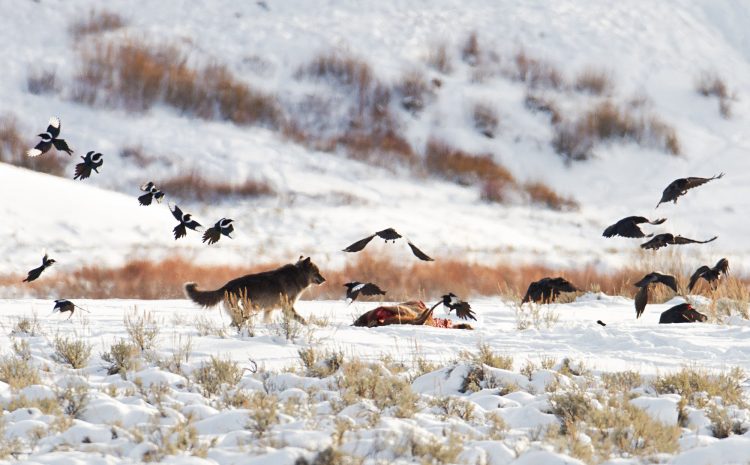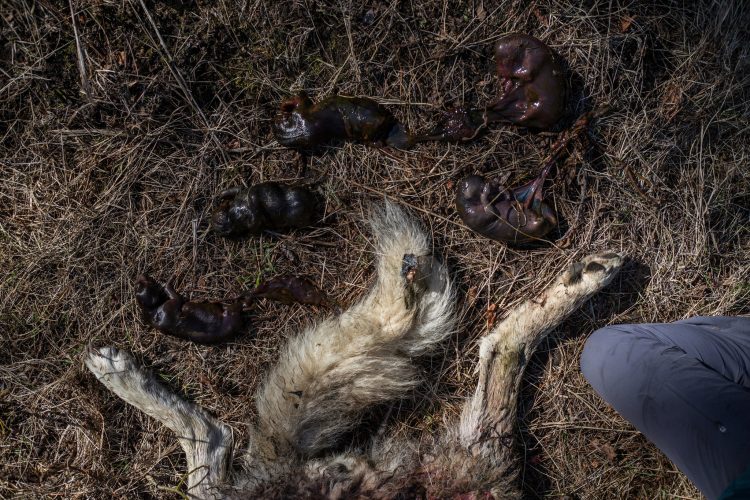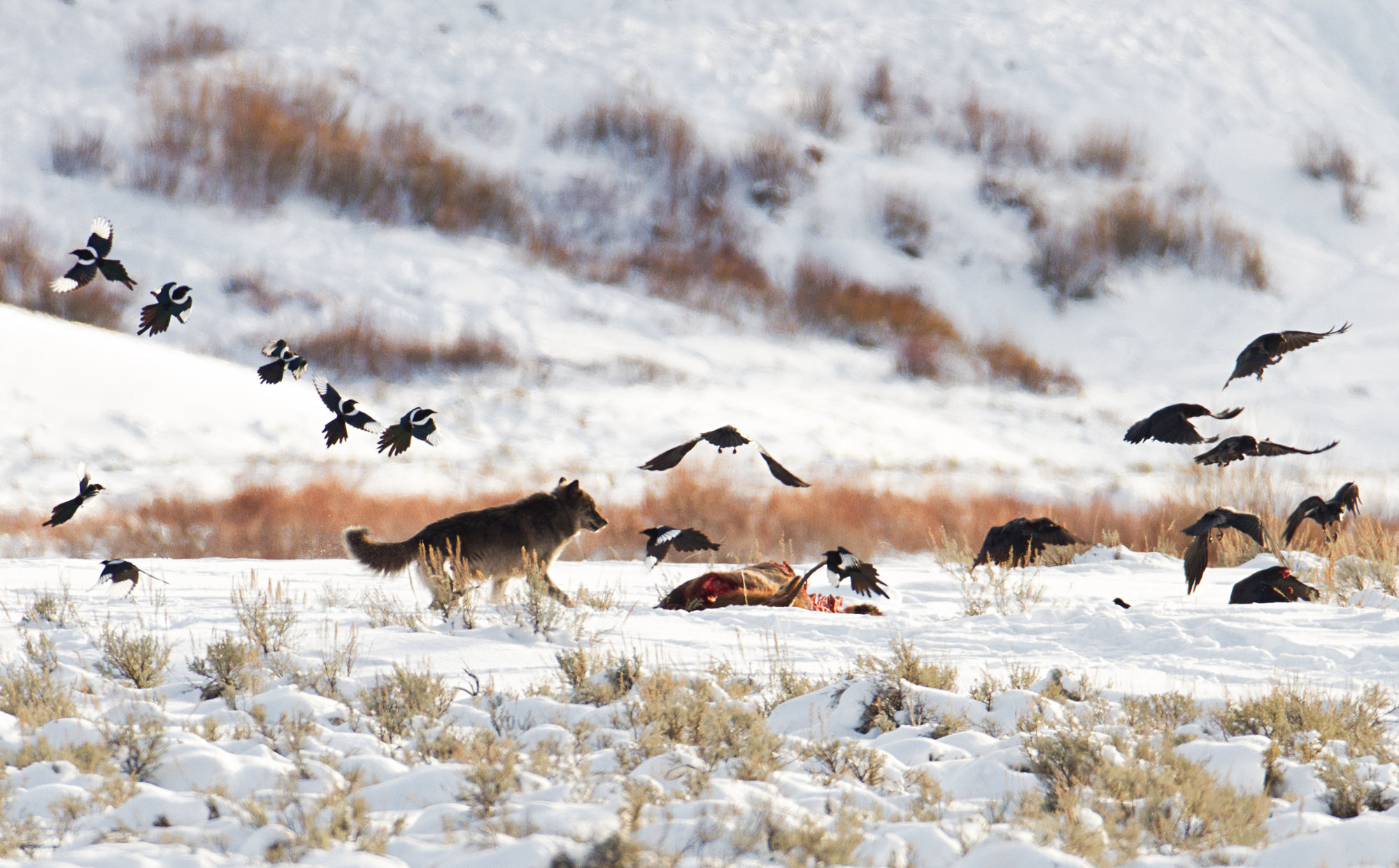
The Primary Reason we need to fight even harder for Buffer Zones around all National Parks, Canada is pushing for 50KM, we need to do the same. There only about 1,700 Wolves Left in the Western states of Montana, Idaho, Wyoming, Oregon and Washington.
YELLOWSTONE NATIONAL PARK, Wyo. — The vast, sagebrush-studded valleys in this huge chunk of wild country, teeming with herds of elk and bison, are home these days to 10 packs of wolves.
Once among the first species to be listed as endangered, the gray wolf has made a healthy comeback within Yellowstone National Park and its bordering states. Since 1995-96 when 31 wolves were trucked into the park from Canada, their numbers have grown and stabilized to the point that officials could essentially post a “no vacancy sign” at Yellowstone. That’s because the park’s wolf population has hovered for the last decade at 100, give or take, which experts consider Yellowstone’s carrying capacity.
Protected on parkland, gray wolves show little fear of humans, often living out their lives within view of roads. They attract thousands of tourists a year who sometimes become witnesses to the life-or-death dramas between predator and prey.
And some catch a glimpse of a rare white wolf.
“Yellowstone is the best place in the world to view wolves,” said Douglas Smith, the park’s wolf biologist, as he hiked up a fog-shrouded hill searching for one of the packs.
The sprawling 2.2 million-acre park acts as a laboratory for Dr. Smith and other scientists, who are conducting a long-term study of this very rare population of wolves — unusual because they are neither shot nor trapped. And it turns out a wolf protected from human killing is a very different animal from those that are hunted.
That may change, researchers say, as more hunting is allowed in the states that surround the park.
As the packs grew, many wolves roamed outside the national park, replenishing the wild lands. Wolves now number about 1,700 in the Western states of Montana, Idaho, Wyoming, Oregon and Washington. Threats to livestock have intensified in recent years, pitting ranchers against conservationists and prompting some states to permit limited wolf hunting again at certain times.
In March, a United States Court of Appeals paved the way for Wyoming to join Idaho and Montana in allowing wolf hunting. Wildlife officials are now planning a hunting season on gray wolves for this fall, based on the court’s ruling that the state’s plan to manage wolves was adequate to ensure that the once-threatened species would not be imperiled again by hunting wolves near the park or those that leave it.
Experts say that the gray wolf is no longer in danger of being completely wiped out by hunting. Their extirpation by the 1920s or so was caused by unregulated killing.
But expanding the hunt for wolves around the edges of the park poses several issues at Yellowstone Park, where the management protects wildlife so people can watch and study it.
“What will hunting wolves nearby do to that?” Dr. Smith asked.
A study underway that Yellowstone has joined with Denali and Grand Teton National Parks is examining that very question. A paper published last year by Dr. Smith and others found that sightings of wolves in Denali and Yellowstone “were significantly reduced” by as much as 45 percent from trapping and hunting.
If the wolves become less visible, that could diminish the steady flow of tourism dollars, given that wolf watching in Yellowstone alone is estimated to generate $35 million a year for the regional economy.
Officials in Montana have already placed a quota on the number of wolves that could be shot by hunters north of the park — four each season — to minimize the impact on wolf watching in the park.
Yet another possible effect of expanded hunting would be the disruption of a historic long-term wolf research project. .
Yellowstone’s vast wilderness provides the only place in the world where many packs of wolves, free from human hunting, live in full view of groups of biologists equipped with high-tech research equipment.
Ten of the park’s wolves wear GPS collars that beam their whereabouts as many as 48 times a day to a satellite, providing researchers with unprecedented detail on what wolves do all day.
A team of up to 20 researchers and volunteers, sitting on a hilltop with spotting scopes or peering down from aircraft, witness the daily goings-on year-round. Camera traps record remote wolf activity. And because they have lived without the threat of being shot and with near daily tourist traffic — the wolves ignore the researchers and are readily observed.
As a result, a complex and in some cases unprecedented portrait of wolves is emerging.
For example, protected wolves regard humans very differently. “Wolf hunters talk about seeing a pack of park wolves outside the boundary, and being able to pick the one they want,” Dr. Smith said. “They just stand there and have no fear.”
While all wolves are very social with a hierarchy, those pack rules are often corrupted when human hunting enters the picture. In the park, researchers are getting a thorough look at pure wolf social dynamics — within and between packs.
For the first time, pack longevity has been studied in depth, the life span of a pack is eight to 10 years in the park. One pack called the Druid is more than 20 years old. Hunted wolf packs, on the other hand, often last just two or three years. When one or two of the wolves are shot or trapped, members of the pack often scatter and reform with different members.
Park wolves live to be about five, double the life span outside its borders. Yellowstone’s oldest wolf reached 12 ½ years.

Near the end of her necropsy of the wolf 909F, Kira Cassidy, a Park Service biologist, discovered five unborn pups that were likely within days of birth when their mother was killed by an elk. Samples from the pups will allow biologists to determine who the father or fathers were, confirm their sex, and determine what color they would have been
Source: The New Threat to Wolves in and Around Yellowstone – The New York Times
